Influence of Tool Geometry and Process Parameters on the Properties of Friction Stir Spot Welded Multiple (AA 5754 H111) Aluminium Sheets
Abstract
:1. Introduction
2. Materials and Methods
3. Results and Discussions
3.1. Coefficient of Friction (CoF)
3.2. Weld Joint Analysis
3.3. Scaning Acoustic Microscope (SAM) Analysis
3.4. Microstructural Evaluation
3.5. Mechanical Properties
3.5.1. Vickers Microhardness
3.5.2. Small Punch Test
3.5.3. Structure and Dimensional Evaluation of the Small Punch Test Samples
4. Conclusions
- The two types of pinless tools used in this investigation provided weld joints of multiple thin sheets (0.3 mm) of AA 5754-H111 aluminium alloy at various rotational speeds.
- The kinetic coefficient of friction (CoF) was found to be dependent on the rotational speed used. For example, at low rotational speeds, as a strain hardening effect occurs, the CoF increased up to the end of the process. However, in samples welded at higher rotational speeds thermal softening caused a decrease of CoF over the dwell time.
- Macrographs and SAM analysis proved no defect in the top two weld interfaces. However, delamination circles were found at the bottom most interface. The volume of delamination circles increases with increasing rotation speed. The welds obtained from one particular tool produced a wider stir zone compared to those obtained with the other tool. In both batches, the shape of the stir zone varies from almost cylindrical at low rotational speed to conical at higher rotational speeds.
- All samples experienced different grain sizes and shapes of SZ, TMAZ, HAZ and BM. The grain size was highest in based materials (BM) followed by HAZ, TMAZ and finally stir zone: Depending on the rotational speed, different widths of the TMAZ and grain shape inside of it were seen. Grain size decreases with decreasing rotational speed.
- Microhardness and weld efficiency showed, that in samples welded at low rotational speed, improved mechanical properties were obtained compared to the base material due to a dominant strain hardening mechanism while in samples welded at higher rotational speed thermal softening caused a reduction in the mechanical properties, particularly fracture strength. Low rotational speeds caused a 14.4% and 12.8% increase in joint efficiency compared to high rotational speeds for the two types of tools used in this study.
Author Contributions
Funding
Informed Consent Statement
Data Availability Statement
Acknowledgments
Conflicts of Interest
Abbreviations
| BM | Base material |
| CDRX | Continuous dynamic recrystallisation |
| CoF | Coefficient of friction |
| CRM | Crittical raw materials |
| ECA | Edge chipping area |
| FBJ | Friction bit joining |
| FSS | Flat friction stir scribe |
| FSW | Friction stir welding |
| FSSW | Friction stir spot welding |
| HAZ | Heat affected zone |
| LEDS | Low energy dislocation structure |
| RSW | Resistance spot welding |
| SAM | Scanning acoustic microscopy |
| SCA | Stabile contact area |
| SEM | Scanning electron microscopy |
| SPT | Small punch test |
| SZ | Stir zone |
| TMAZ | Thermo-mechanicaly affected zone |
| WFI | Weld faing interface |
| Nomenclature | |
| F | Axial load |
| n | Rotational speed |
| h | Penetration depth |
| td | Dwell time |
| τ | Shear stress |
| σn | Nominal stress |
| T | Torque |
| FN | Axial Load |
| r(t) | Rool contact radius |
| Fr | Radial load chaused bz clamping system |
| Fec | Load chausing edge clamping |
| Fec - shear | Shear load chausing edge cliping |
| Ffriction | Friction load |
| Fnormal | Predominant axial load |
| Fshear | Shear load |
| E | Joint efficienty |
| Rm(weld) | Weld strength |
| Rm(BM) | Base material strength |
| Fm(weld) | Rapture load of the welds |
| Fm(BM) | Rapture load of the base material |
| d | Bottom diameter of the stir zone |
| D | Top diameter of the stir zone |
References
- Chu, Q.; Yang, X.W.; Li, W.Y.; Lu, T.; Zhang, Y.; Vairis, A.; Wang, W.B. Impact of surface state in probeless friction stir spot welding of an Al–Li alloy. Sci. Technol. Weld. Join. 2019, 24, 200–208. [Google Scholar] [CrossRef]
- Klobčar, D.; Tušek, J.; Smolej, A.; Simončič, S. Parametric study of FSSW of aluminium alloy 5754 using a pinless tool. Weld. World 2014, 59, 269–281. [Google Scholar] [CrossRef]
- Chu, Q.; Yang, X.W.; Li, W.; Li, Y. Microstructure and mechanical behaviour of pinless friction stir spot welded AA2198 joints. Sci. Technol. Weld. Join. 2016, 21, 164–170. [Google Scholar] [CrossRef]
- Meng, X.; Huang, Y.; Cao, J.; Shen, J.; dos Santos, J.F. Recent progress on control strategies for inherent issues in friction stir welding. Prog. Mater. Sci. 2021, 115, 100706. [Google Scholar] [CrossRef]
- Base Metals Prices. Available online: https://www.fastmarkets.com/commodities/base-metals/prices (accessed on 23 January 2021).
- What Are the Most Relevant Physical Properties for Copper and Aluminium in Electrical Applications? Available online: https://help.leonardo-energy.org/hc/en-us/articles/202671931-What-are-the-most-relevant-physical-properties-for-copper-and-aluminium-in-electrical-applications- (accessed on 23 January 2021).
- Metal Properties Table. Available online: https://www.tibtech.com/conductivite.php?lang=en_US (accessed on 23 January 2021).
- Regensburg, A.; Petzoldt, F.; Benss, T.; Bergmann, J.P. Liquid interlayer formation during friction stir spot welding of aluminum/copper. Weld. World 2018, 63, 117–125. [Google Scholar] [CrossRef]
- Labus Zlatanovic, D.; Balos, S.; Bergmann, J.P.; Köhler, T.; Grätzel, M.; Sidjanin, L.; Goel, S. An experimental study on lap joining of multiple sheets of aluminium alloy (AA 5754) using friction stir spot welding. Int. J. Adv. Manuf. Technol. 2020, 107, 3093–30107. [Google Scholar] [CrossRef]
- Güler, H. Influence of the tool geometry and process parameters on the static strength and hardness of friction-stir spot-welded aluminium-alloy sheets. Mater. Tehnol. 2015, 49, 457–460. [Google Scholar] [CrossRef]
- El Rayes, M.M.; Soliman, M.S.; Abbas, A.T.; Pimenov, D.Y.; Erdakov, I.N.; Abdel-Mawla, M.M. Effect of Feed Rate in FSW on the Mechanical and Microstructural Properties of AA5754 Joints. Adv. Mater. Sci. Eng. 2019, 2019, 12. [Google Scholar] [CrossRef] [Green Version]
- Mousavizade, S.M.; Pouranvari, M. Projection friction stir spot welding: A pathway to produce strong keyhole-free welds. Sci. Technol. Weld. Join. 2019, 24, 256–262. [Google Scholar] [CrossRef]
- Suresh, S.; Elango, N.; Venkatesan, K.; Lim, W.H.; Palanikumar, K.; Rajesh, S. Sustainable friction stir spot welding of 6061-T6 aluminium alloy using improved non-dominated sorting teaching learning algorithm. J. Mater. Res. Technol. 2020, 9, 11650–11674. [Google Scholar] [CrossRef]
- Suryanarayanan, R.; Sridhar, V.G. Process parameter optimisation in pinless friction stir spot welding of dissimilar aluminium alloys using Multi-start algorithm. Proc. Inst. Mech. Eng. Part C J. Mech. Eng. Sci. 2020, 234, 4101–4115. [Google Scholar] [CrossRef]
- Mubiayi, M.P.; Akinlabi, E.T.; Makhatha, M.E. Current state of friction stir spot welding between aluminium and copper. Mater. Today Proc. 2018, 5, 18633–18640. [Google Scholar] [CrossRef]
- BBobba, S.; Carrara, S.; Huisman, J.; Mathieux, F.; Pavel, C. Critical Raw Materials for Strategic Technologies and Sectors in the EU—A Foresight Study; European Commission: Brussels, Belgium, 2020; ISBN 9789276153375. [Google Scholar]
- Manladan, S.M.; Yusof, F.; Ramesh, S.; Fadzil, M.; Luo, Z.; Ao, S. A review on resistance spot welding of aluminum alloys. Int. J. Adv. Manuf. Technol. 2017, 90, 605–634. [Google Scholar] [CrossRef]
- Ojo, O.O.; Taban, E.; Kaluc, E. Friction stir spot welding of aluminum alloys: A recent review. Mater. Test. 2015, 57, 595–627. [Google Scholar] [CrossRef]
- Shahani, A.; Farrahi, A. Effect of stirring time on the mechanical behavior of friction stir spot weld of Al 6061-T6 lap-shear configuration. Proc. Inst. Mech. Eng. Part C J. Mech. Eng. Sci. 2019, 233, 3583–3591. [Google Scholar] [CrossRef]
- Sharma, C.; Dwivedi, D.K.; Kumar, P. Effect of welding parameters on microstructure and mechanical properties of friction stir welded joints of AA7039 aluminum alloy. Mater. Des. 2012, 36, 379–390. [Google Scholar] [CrossRef]
- Enami, M.; Farahani, M.; Farhang, M. Novel study on keyhole less friction stir spot welding of Al 2024 reinforced with alumina nanopowder. Int. J. Adv. Manuf. Technol. 2019, 101, 3093–3106. [Google Scholar] [CrossRef]
- Li, G.; Zhou, L.; Luo, L.; Wu, X.; Guo, N. Microstructural evolution and mechanical properties of refill friction stir spot welded alclad 2A12-T4 aluminum alloy. J. Mater. Res. Technol. 2019, 8, 4115–4129. [Google Scholar] [CrossRef]
- Yang, X.W.; Fu, T.; Li, W.Y. Friction Stir Spot Welding: A Review on Joint Macro- and Microstructure, Property, and Process Modelling. Adv. Mater. Sci. Eng. 2014, 2014, 1–11. [Google Scholar] [CrossRef] [Green Version]
- Sun, Y.; Fujii, H.; Zhu, S.; Guan, S. Flat friction stir spot welding of three 6061-T6 aluminum sheets. J. Mater. Process. Technol. 2019, 264, 414–421. [Google Scholar] [CrossRef]
- Huang, T.; Sato, Y.S.; Kokawa, H.; Miles, M.P.; Kohkonen, K.; Siemssen, B.; Steel, R.J.; Packer, S. Microstructural evolution of DP980 steel during friction bit joining. Metall. Mater. Trans. A Phys. Metall. Mater. Sci. 2009, 40, 2994–3000. [Google Scholar] [CrossRef]
- Zhang, Z.; Yang, X.; Zhang, J.; Zhou, G.; Xu, X.; Zou, B. Effect of welding parameters on microstructure and mechanical properties of friction stir spot welded 5052 aluminum alloy. Mater. Des. 2011, 32, 4461–4470. [Google Scholar] [CrossRef]
- Cox, C.D.; Gibson, B.T.; Delapp, D.R.; Strauss, A.M.; Cook, G.E. A method for double-sided friction stir spot welding. J. Manuf. Process. 2014, 16, 241–247. [Google Scholar] [CrossRef]
- Li, W.; Li, J.; Zhang, Z.; Gao, D.; Wang, W.; Dong, C. Improving mechanical properties of pinless friction stir spot welded joints by eliminating hook defect. Mater. Des. 2014, 62, 247–254. [Google Scholar] [CrossRef]
- Yazdi, S.R.; Beidokhti, B.; Haddad-Sabzevar, M. Pinless tool for FSSW of AA 6061-T6 aluminum alloy. J. Mater. Process. Technol. 2019, 267, 44–51. [Google Scholar] [CrossRef]
- Bakavos, D.; Chen, Y.; Babout, L.; Prangnell, P. Material interactions in a novel pinless tool approach to friction stir spot welding thin aluminum sheet. Metall. Mater. Trans. A Phys. Metall. Mater. Sci. 2011, 42, 1266–1282. [Google Scholar] [CrossRef]
- Tran, V.X.; Pan, J.; Pan, T. Effects of processing time on strengths and failure modes of dissimilar spot friction welds between aluminum 5754-O and 7075-T6 sheets. J. Mater. Process. Technol. 2009, 209, 3724–3739. [Google Scholar] [CrossRef]
- Schneider, C.A.; Rasband, W.S.; Eliceiri, K.W. NIH Image to ImageJ: 25 years of image analysis. Nat. Methods 2012, 9, 671–675. [Google Scholar] [CrossRef] [PubMed]
- BS EN ISO 6507-1 2018 Vickers Hardness Test—Part 1. 2018, pp. 1–30. Available online: https://infostore.saiglobal.com/preview/is/en/2006/i.s.eniso6507-1-2018.pdf?sku=557814 (accessed on 23 January 2021).
- Rasche, S.; Kuna, M. Improved small punch testing and parameter identification of ductile to brittle materials. Int. J. Press. Vessel. Pip. 2015, 125, 23–34. [Google Scholar] [CrossRef]
- Rasche, S. Bestimmung von Materialparametern der Elastish-Plastischen Verformung und des Spröden Versagens aus Smal-Punch-Lkeinstproben; Technische Universität Bergakademie Freiberg: Freiberg, Germany, 2013. [Google Scholar]
- CEN CWA 15627: Small Punch Test Method for Metalic Materials; European Committee for Standardization CEN: Brussels, Belgium, 2006.
- Kalpakijan, S. Manufacturing Processes for Engineering Materials; Addison Wesley Publishing Company: Boston, MA, USA, 1991. [Google Scholar]
- Song, M.; Kovacevic, R. Thermal modeling of friction stir welding in a moving coordinate system and its validation. Int. J. Mach. Tools Manuf. 2003, 43, 605–615. [Google Scholar] [CrossRef]
- Frigaard, Ø; Grong, Ø; Midling, O.T. A process model for friction stir welding of age hardening aluminum alloys. Metall. Mater. Trans. A Phys. Metall. Mater. Sci. 2001, 32, 1189–1200. [Google Scholar] [CrossRef]
- Goel, S.; Cross, G.; Stukowski, A.; Gamsjäger, E.; Beake, B.; Agrawal, A. Designing nanoindentation simulation studies by appropriate indenter choices: Case study on single crystal tungsten. Comput. Mater. Sci. 2018, 152, 196–210. [Google Scholar] [CrossRef] [Green Version]
- Farhat, Z.N.; Ding, Y.; Northwood, D.O.; Alpas, A.T. Effect of grain size on friction and wear of nanocrystalline aluminum. Mater. Sci. Eng. A 1996, 206, 302–313. [Google Scholar] [CrossRef]
- Kumar, K.; Kalyan, C.; Kailas, S.V.; Srivatsan, T.S. An Investigation of Friction During Friction Stir Welding of Metallic Materials. Mater. Manuf. Process. 2009, 24, 438–445. [Google Scholar] [CrossRef]
- Wei, S.; Liu, Y.; Liu, X.; Zhao, H. Investigation on edge chipping evaluation of Si 3 N 4 ceramics milling surface. Meas. J. Int. Meas. Confed. 2019, 133, 241–250. [Google Scholar] [CrossRef]
- Kuhlmann-Wilsdorf, D.; Wilsdorf, H.G.F.; Wert, J.A. LEDS theory of workhardening stages and “planar” versus “distributed” glide. Scr. Metall. Mater. 1994, 31, 729–734. [Google Scholar] [CrossRef]
- Jata, K.V.; Semiatin, S.L. Continuous dynamic recrystallization during friction stir welding of high strength aluminum alloys. Scr. Mater. 2000, 43, 743–749. [Google Scholar] [CrossRef]
- Gerlich, A.; Su, P.; Yamamoto, M.; North, T.H. Effect of welding parameters on the strain rate and microstructure of friction stir spot welded 2024 aluminum alloy. J. Mater. Sci. 2007, 42, 5589–5601. [Google Scholar] [CrossRef]
- Bagheri, B.; Abbasi, M.; Abdollahzadeh, A.; Omidvar, H. Advanced Approach to Modify Friction Stir Spot Welding Process. Met. Mater. Int. 2019. [Google Scholar] [CrossRef]
- Cao, J.Y.; Wang, M.; Kong, L.; Zhao, H.X.; Chai, P. Microstructure, texture and mechanical properties during refill friction stir spot welding of 6061-T6 alloy. Mater. Charact. J. 2014, 128, 54–62. [Google Scholar] [CrossRef]
- McNelley, T.R.; Swaminathan, S.; Su, J.Q. Recrystallization mechanisms during friction stir welding/processing of aluminum alloys. Scr. Mater. 2008, 58, 349–354. [Google Scholar] [CrossRef] [Green Version]
- Zlatanovic, D.L.; Balos, S.; Bergmann, J.P.; Goel, S.; Sidjanin, L. Influence of rotational speed on weld shape during friction stir spot welding. In Proceedings of the 9th International Scientific Conference on Defensive Technologies, Belgrade, Serbia, 15–16 October 2020; pp. 1–5. [Google Scholar]
- Mishra, R.; Ma, Z. Ma Friction stir welding and processing. Mater. Sci. Eng. R 2005, 50, 1–78. [Google Scholar] [CrossRef]
- Shen, Z.; Yang, X.; Yang, S.; Zhang, Z.; Yin, Y. Microstructure and mechanical properties of friction spot welded 6061-T4 aluminum alloy. Mater. Des. 2014, 54, 766–778. [Google Scholar] [CrossRef]
- Sahu, P.K.; Vasudevan, N.P.; Das, B.; Pal, S. Assessment of self-reacting bobbin tool friction stir welding for joining AZ31 magnesium alloy at inert gas environment. J. Magnes. Alloy. 2019, 7, 661–671. [Google Scholar] [CrossRef]
- Thomas, W.M.; Nicholas, E.D.; Needham, J.C.; Murch, M.G.; Temple Smith, P.; Dawes, C.J. Friction Stir Butt Welding. U.S. Patent Application No. PCT/GB92/02203, December 1991. [Google Scholar]
- Mishra, R.S.; Mahoney, M.W.; Mcfadden, S.X.; Mara, N.A.; Mukherjee, A.K. High Strain Rate Superplasticity In a Friction Stir Processed 7075 Al Alloy. Scr. Mater. 2000, 42, 163–168. [Google Scholar] [CrossRef]
- Babu, S.; Sankar, V.S.; Janaki Ram, G.D.; Venkitakrishnan, P.V.; Madhusudhan Reddy, G.; Prasad Rao, K. Microstructures and mechanical properties of friction stir spot welded aluminum alloy AA2014. J. Mater. Eng. Perform. 2013, 22, 71–84. [Google Scholar] [CrossRef]
- Jan, A.; Siegl, J.; Hau, P. Small punch test evaluation methods for material characterisation. J. Nucl. Mater. 2016, 481, 201–213. [Google Scholar] [CrossRef]
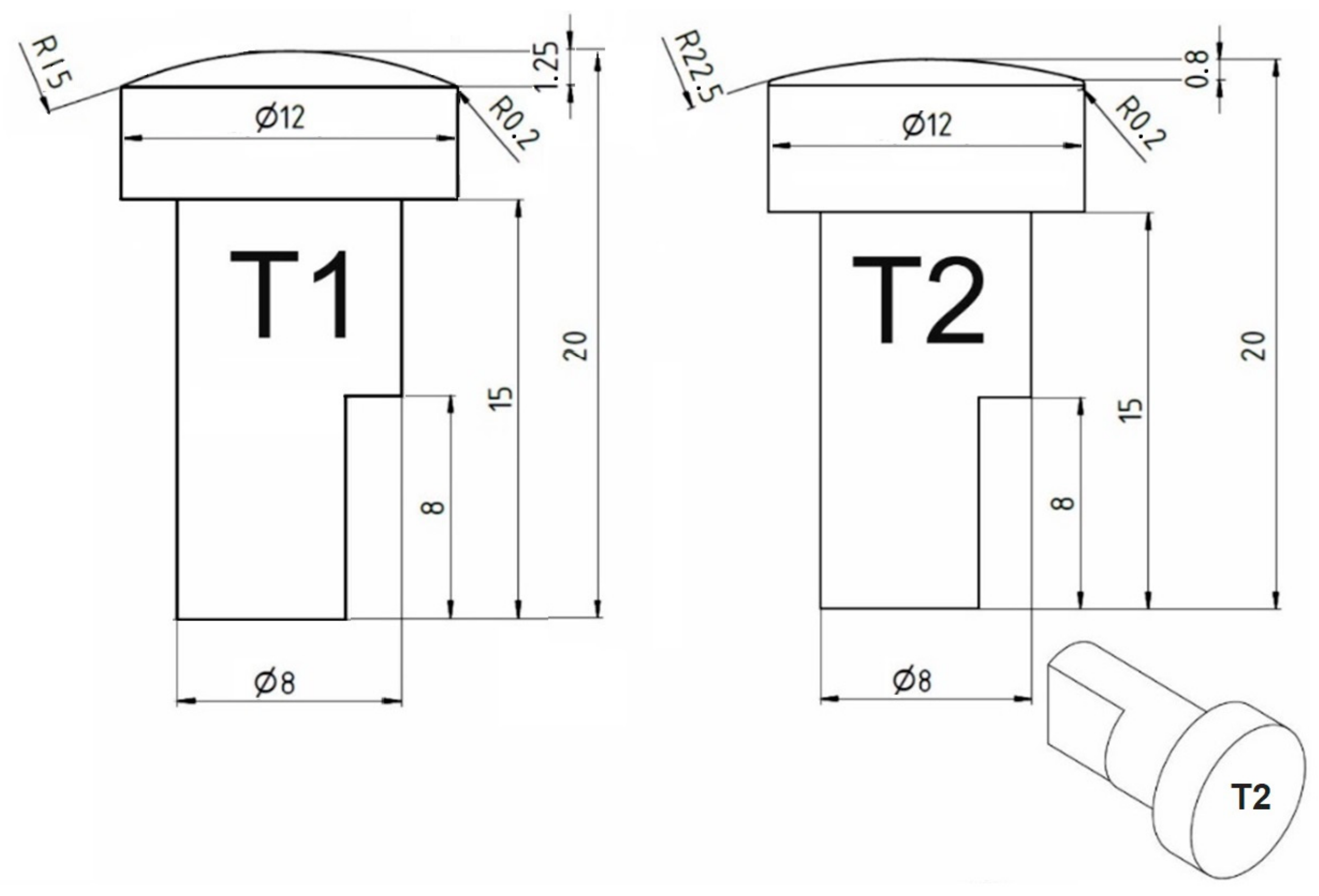

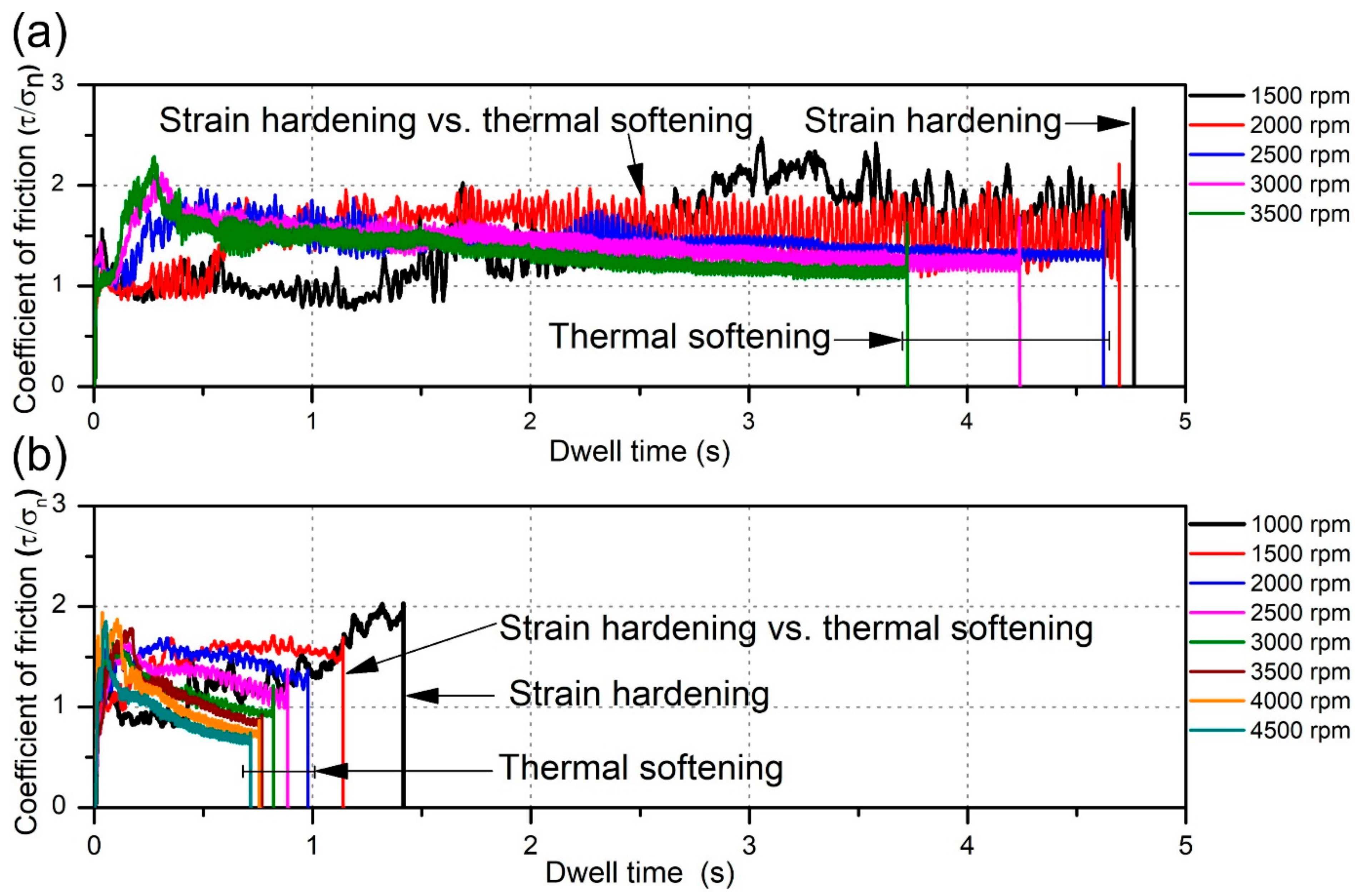
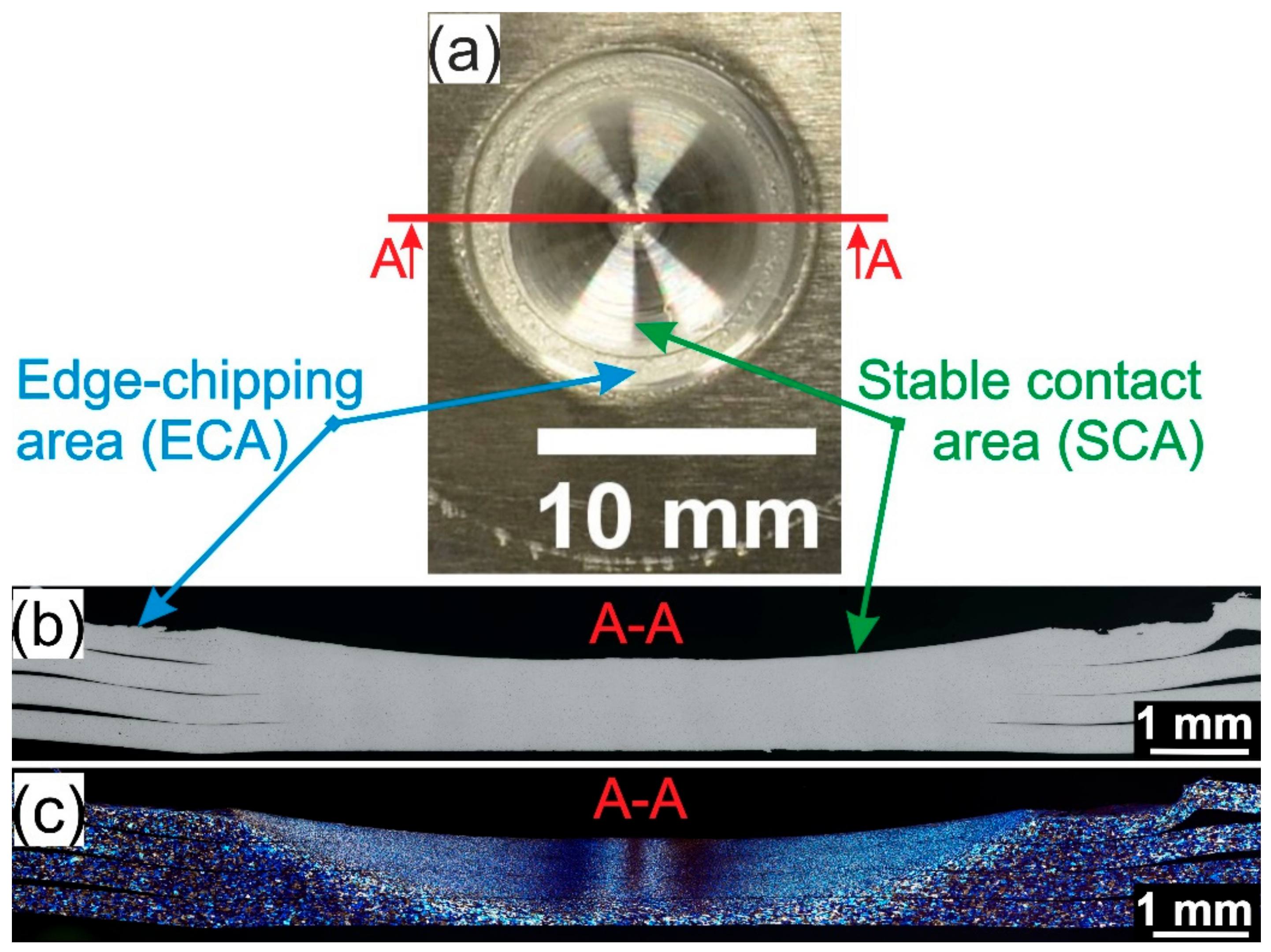
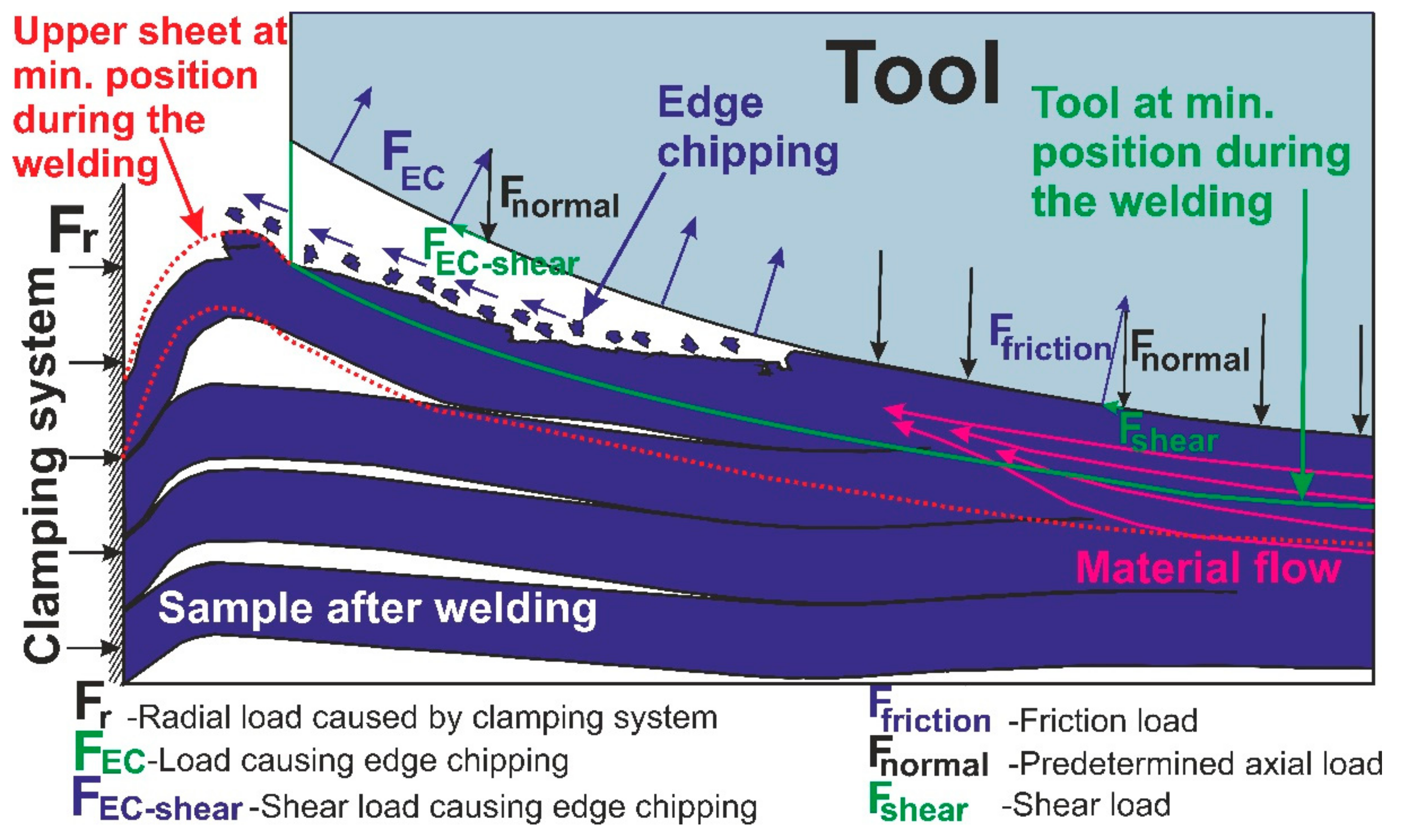

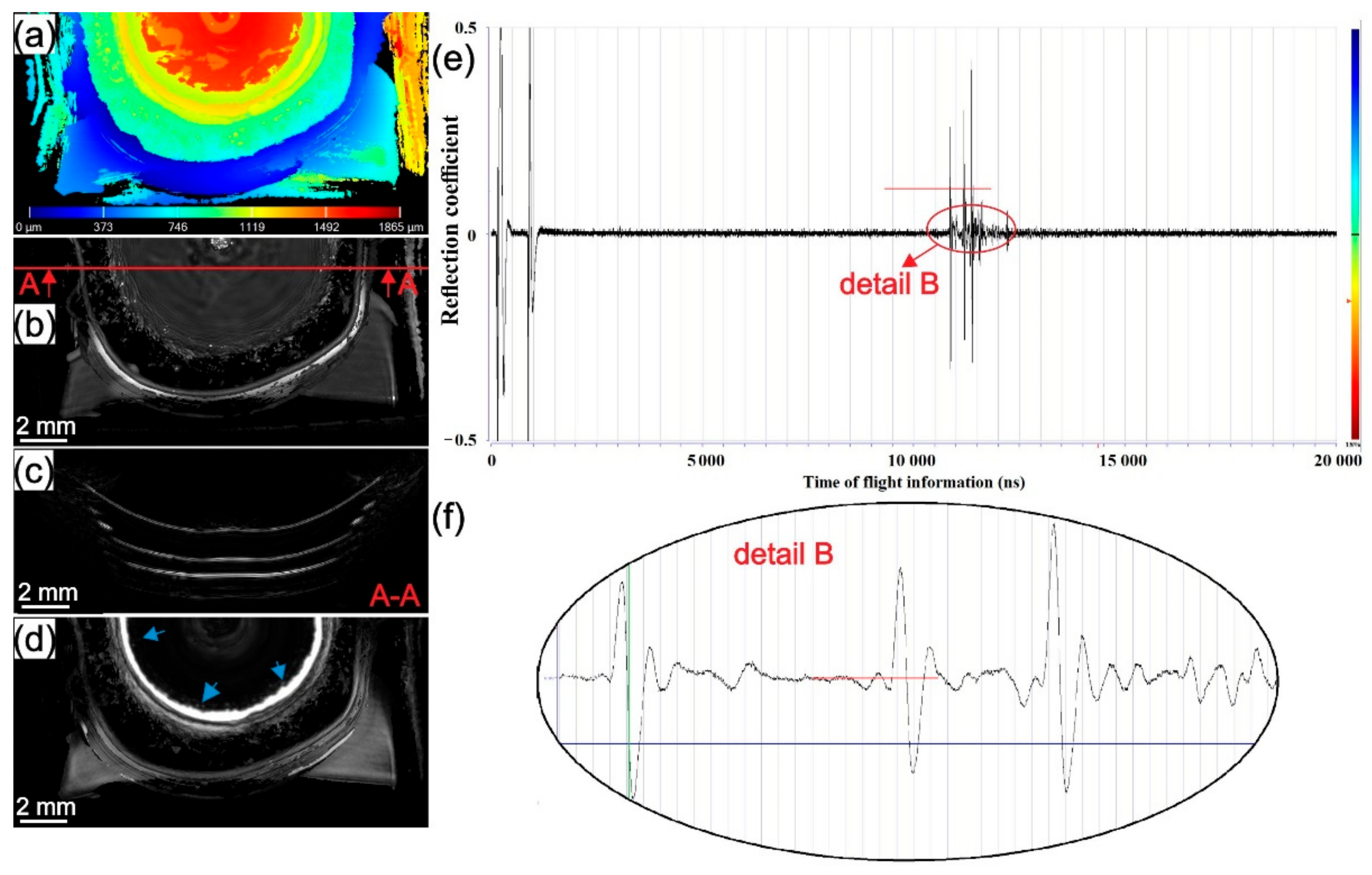
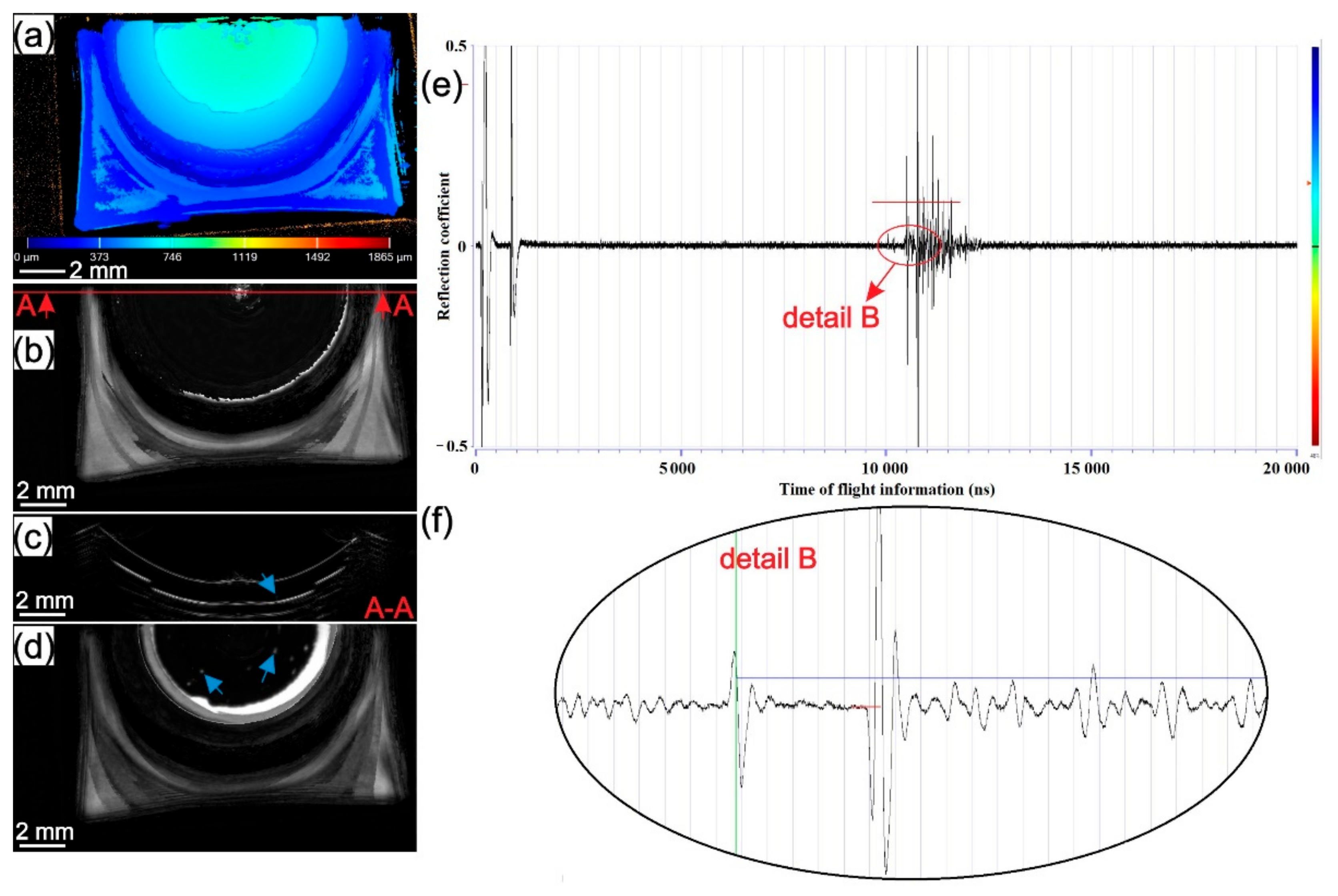



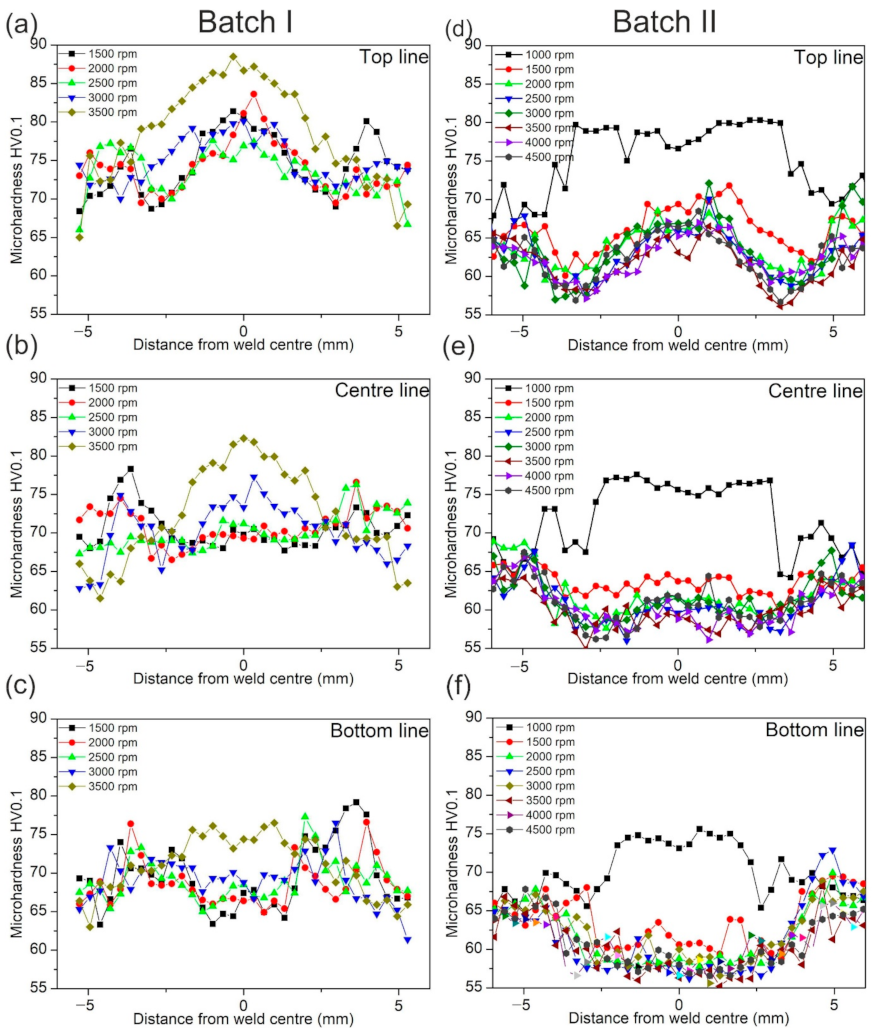
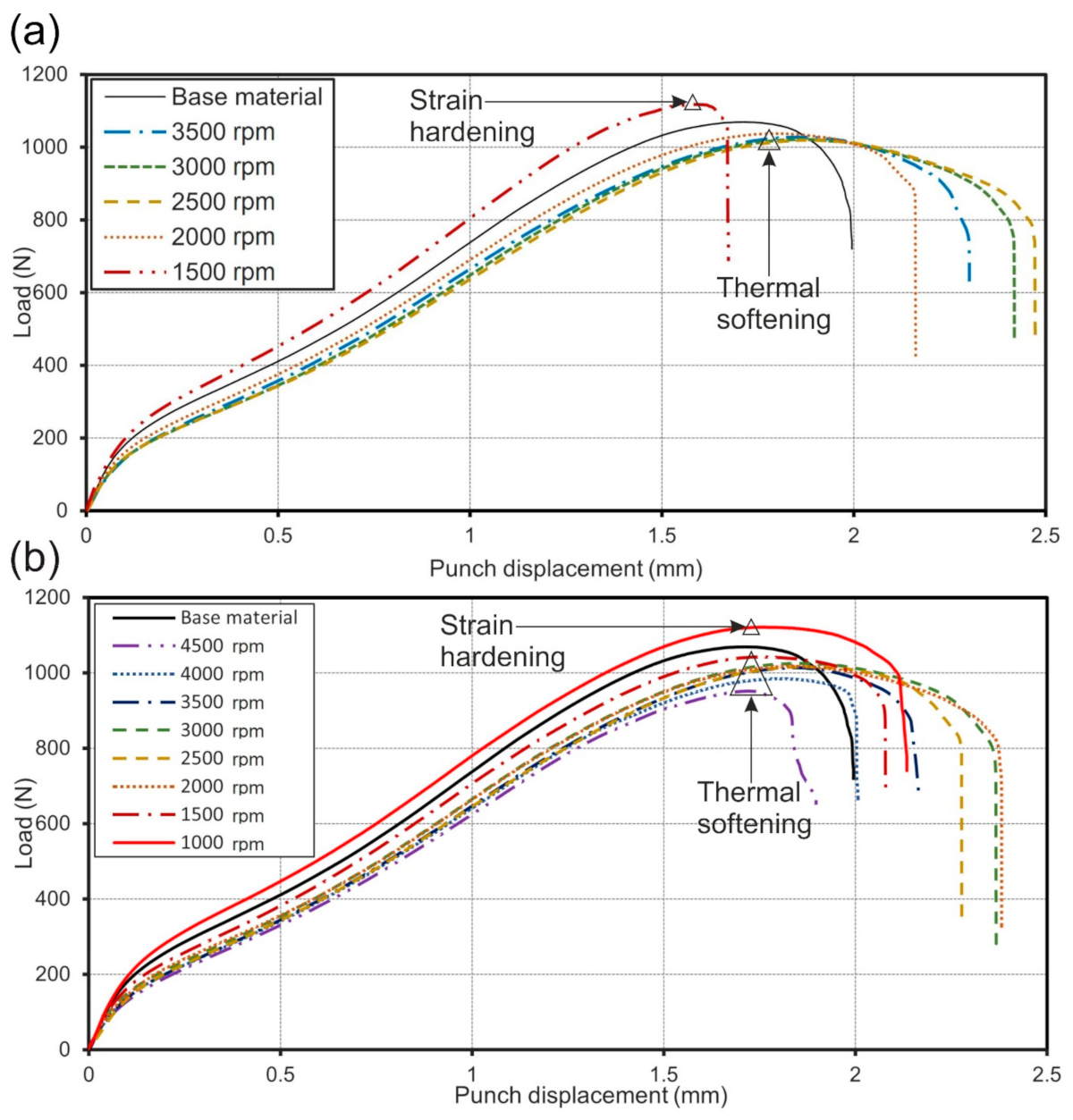
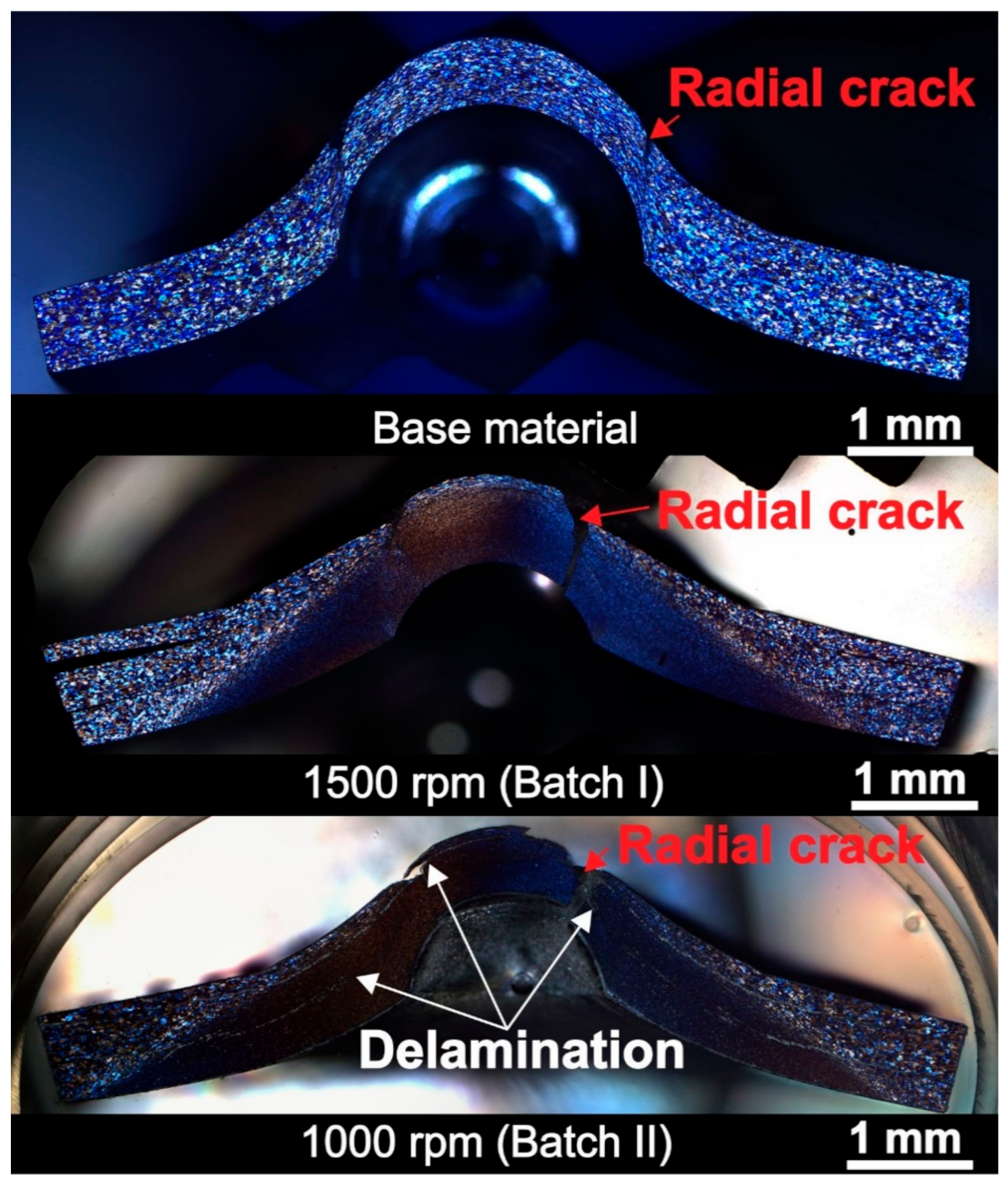

| Element | Si | Fe | Cu | Mn | Mg | Cr | Zn | Ti | Al |
|---|---|---|---|---|---|---|---|---|---|
| wt. (%) | 0.19 | 0.24 | 0.03 | 0.30 | 3.10 | 0.03 | 0.005 | 0.014 | bal. |
| Material | Min. Yield Strength (MPa) | Tensile Strength (MPa) | Elongation-A50 (%) |
|---|---|---|---|
| AA 5754-H111 | 80 | 190 ÷ 240 | 12 |
| Batch I (T1) * | Axial Load F (kN) | Rotational Speed n (rpm) | Penetration Depth h (mm) | Dwell Time td (s) | Dwell Time Deviation td (s) | Batch II (T2) * | Axial Load F (kN) | Rotational Speed n (rpm) | Penetration Depth h (mm) | Dwell Time td (s) | Dwell Time Deviation td (s) |
|---|---|---|---|---|---|---|---|---|---|---|---|
| RW1 | 2 | 1500 | 0.25 | 4.65 | 0.268 | RWA1 | 4 | 1000 | 0.25 | 1.68 | 0.070 |
| RW2 | 2 | 2000 | 0.25 | 4.60 | 0.340 | RWA2 | 4 | 1500 | 0.25 | 1.34 | 0.042 |
| RW3 | 2 | 2500 | 0.25 | 4.41 | 0.298 | RWA3 | 4 | 2000 | 0.25 | 1.11 | 0.081 |
| RW4 | 2 | 3000 | 0.25 | 4.29 | 0.212 | RWA4 | 4 | 2500 | 0.25 | 1.07 | 0.076 |
| RW5 | 2 | 3500 | 0.25 | 3.77 | 0.148 | RWA5 | 4 | 3000 | 0.25 | 0.97 | 0.040 |
| RWA6 | 4 | 3500 | 0.25 | 1.00 | 0.038 | ||||||
| RWA7 | 4 | 4000 | 0.25 | 0.98 | 0.042 | ||||||
| RWA8 | 4 | 4500 | 0.25 | 0.91 | 0.015 |
| Base Material | 4500 rpm | 4000 rpm | 3500 rpm | 3000 rpm | 2500 rpm | 2000 rpm | 1500 rpm | 1000 rpm | |
|---|---|---|---|---|---|---|---|---|---|
| Batch I | |||||||||
| Rupture Load Fm (N) | 1094.9 | 1004 | 1030.2 | 1010.3 | 1043 | 1162 | |||
| Standard Deviation | 21.3 | 37.83 | 3.69 | 4.14 | 58.01 | 9.51 | |||
| Joint Efficiency E (%) | − | 91.7 | 94.1 | 92.3 | 95.3 | 106.1 | |||
| Batch II | |||||||||
| Rupture Load Fm (N) | 1094.9 | 957.2 | 991.9 | 1002.9 | 1001.9 | 1021.3 | 1016.6 | 1040.3 | 1096.7 |
| Standard Deviation | 21.3 | 10.3 | 5.7 | 13.4 | 17.4 | 23.3 | 3.6 | 1.9 | 33.5 |
| Joint efficiency E (%) | − | 87.4 | 90.6 | 91.6 | 91.5 | 93.3 | 92. 8 | 95 | 100.2 |
| Specimen Thinning | 4500 rpm | 4000 rpm | 3500 rpm | 3000 rpm | 2500 rpm | 2000 rpm | 1500 rpm | 1000 rpm | |
|---|---|---|---|---|---|---|---|---|---|
| Batch I | (mm) | 0.35 ± 0.01 | 0.48 ± 0.03 | 0.39 ± 0.02 | 0.32 ± 0.01 | 0.12 ± 0.01 | |||
| (%) | 43.8 ± 1.25 | 60 ± 3.75 | 48.8 ± 2.5 | 40 ± 2.5 | 15 ± 1.25 | ||||
| Batch II | (mm) | 0.19 ± 0.03 | 0.36 ± 0.02 | 0.28 ± 0.03 | 0.29 ± 0.01 | 0.26 ± 0.02 | 0.26 ± 0.02 | 0.28 ± 0.01 | 0.17 ± 0.01 |
| (%) | 23.8 ± 3.75 | 45 ± 2.5 | 35 ± 3.75 | 36.3 ± 1.25 | 32.5 ± 2.5 | 32.5 ± 2.5 | 35 ± 1.25 | 21.3 ± 1.25 | |
| Base material | (mm) | 0.27 ± 0.3 | |||||||
| (%) | 33.75 ± 3.75 | ||||||||
Publisher’s Note: MDPI stays neutral with regard to jurisdictional claims in published maps and institutional affiliations. |
© 2021 by the authors. Licensee MDPI, Basel, Switzerland. This article is an open access article distributed under the terms and conditions of the Creative Commons Attribution (CC BY) license (http://creativecommons.org/licenses/by/4.0/).
Share and Cite
Labus Zlatanovic, D.; Balos, S.; Bergmann, J.P.; Rasche, S.; Pecanac, M.; Goel, S. Influence of Tool Geometry and Process Parameters on the Properties of Friction Stir Spot Welded Multiple (AA 5754 H111) Aluminium Sheets. Materials 2021, 14, 1157. https://doi.org/10.3390/ma14051157
Labus Zlatanovic D, Balos S, Bergmann JP, Rasche S, Pecanac M, Goel S. Influence of Tool Geometry and Process Parameters on the Properties of Friction Stir Spot Welded Multiple (AA 5754 H111) Aluminium Sheets. Materials. 2021; 14(5):1157. https://doi.org/10.3390/ma14051157
Chicago/Turabian StyleLabus Zlatanovic, Danka, Sebastian Balos, Jean Pierre Bergmann, Stefan Rasche, Milan Pecanac, and Saurav Goel. 2021. "Influence of Tool Geometry and Process Parameters on the Properties of Friction Stir Spot Welded Multiple (AA 5754 H111) Aluminium Sheets" Materials 14, no. 5: 1157. https://doi.org/10.3390/ma14051157
APA StyleLabus Zlatanovic, D., Balos, S., Bergmann, J. P., Rasche, S., Pecanac, M., & Goel, S. (2021). Influence of Tool Geometry and Process Parameters on the Properties of Friction Stir Spot Welded Multiple (AA 5754 H111) Aluminium Sheets. Materials, 14(5), 1157. https://doi.org/10.3390/ma14051157








